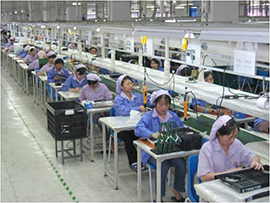Ryder Industries is an EMS company Headquartered in Hong Kong, with two manufacturing facilities based in Southern China; Shenzhen and Xin Feng, to be exact.
Being strategically situated in these regions, your perception would be of an EMS company dedicated to the mass production and repeatable execution and, whilst Ryder Industries is indeed a gateway to these skills, the customer engagement process begins with collaborative in-house electronic and mechanical design, through to New Product Introduction (NPI) for batch sizes of as little as one unit!
The word ‘link’ is of importance in this unique environment.
 With a skilled workforce of over 2,500 industry experts, nine state-of-the-art SMT lines, and over 1,000,000 sq. ft., of operational floor space, Ryder Industries separates itself from the other EMS providers in Southern China by daring to be different.
With a skilled workforce of over 2,500 industry experts, nine state-of-the-art SMT lines, and over 1,000,000 sq. ft., of operational floor space, Ryder Industries separates itself from the other EMS providers in Southern China by daring to be different.
Ryder’s 1,200 person in Shenzhen facility is where the customer engagement process begins. Ryder Industries serves leading brand names in audio, consumer electronics, safety and security devices, and all things IoT. Visitors are welcomed, and discuss NPI, design, development, Design for Manufacture (DfM), Design for Test (DfT), Design for Cost (DfC) and Design for Commercialisation.
They guide their Original Equipment Manufacturing (OEM) partners through the entire end-to-end supply chain process, offering a strategically simplified supply chain solution. Ryder Industries have deepened their service offering in two distinct ways. They have built their in-house Vertical Integration capabilities required to nurture and grow with their OEM partners and they have invested their resources to build a locally sourced, robust supply chain network, which exists within a two-hour drive of the corridor between their two facilities.
Their in-house extensive suite of Vertical Integration include plastic injection moulding, wooden cabinet making, sheet metal fabrication, spray painting, silk screen printing; UV coating; laser engraving, cable harness, and metal stamping.
By developing this ecosystem, Ryder Industries have positioned themselves in a competitive spot, by removing fragility from the supply chain, whilst accelerating delivery time for an electronic product where speed to market entry is crucial.
The success of this model leverages on the fact that Ryder Industries have a sister facility which mirrors their Shenzhen operations in terms of set-up, systems, and software applications used. Their Xin Feng plant is where their OEM partners come to achieve scale. It’s not giga-production by any means. The Xin Feng facility’s core competence is still low-to-medium volume, high mix or complex, customized assembly, but it is a completely integrated gateway from Shenzhen for seamless production transfer and volume ramp-up, whilst achieving economies of scale.
Henry Wu, CEO commented; “In the early 1990’s, we at Ryder Industries identified a market gap that existed for a Southern China EMS provider who specialized in a smaller batch size production for higher-end products that require a greater level of tailor-made services. Brands like Boa, Blackstar Amplification, Silicon Labs and Harman (now a Samsung company) require a flexible solution which evolves as their demand planning evolves. At Ryder Industries, we have a nimble approach, we can alter our shop floor to meet our customer’s requirements as per the end-user adoption. For some customers’ we literally build ten units per month and for others, we produce over 100,000 units per month, however, the difference is that there may be ten variations and a high degree of customization required to meet brand specifications such, as Pantone color tones and placement.”
Gary Hammerslag, Founder of Boa Technology confirmed; “Our relationship with Ryder Industries commenced in 2001, so over fifteen years ago, and from that point forward, we have worked together with one common goal in mind, success for both parties. Our partnership is rooted in mutual trust and respect, and a desire for a long-term venture. We took part in a co-innovation, developmental project as we studied the products ergonomics and safety standards, by evaluating small batch samples and building specific moulds to test. Fast forward fifteen years and we are so embedded with Ryder Industries that we trust them with our entire end-to-end build. They have displayed the tenacity and determination to create complex mechanical and system assembly, full system level assembly which is right the first time, on time, every time.”
It looks like we are going to need to hit the reset button with regards to our perception of the types of products manufactured by EMS companies in Southern China. A company like Ryder Industries will be at the forefront of change. One who has the foresight to become the low-to-medium volume, tailor-made link to connect OEMs to innovation, technology, and scalable production.






